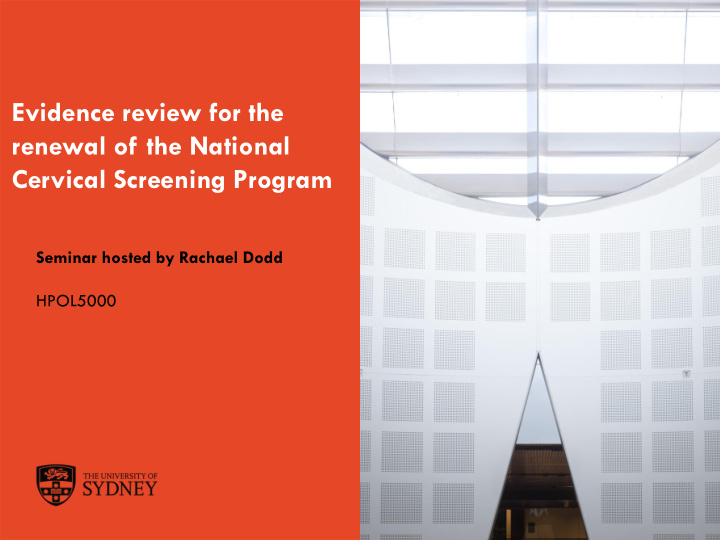



Evidence review for the renewal of the National Cervical Screening Program Seminar hosted by Rachael Dodd HPOL5000 The University of Sydney Page 1
Panel members (left to right) • Dr Megan Smith: Program Manager, Cancer Council NSW • Dr Deborah Bateson: Medical Director, Family Planning NSW • Dr Sally Wortley: Research Fellow, Menzies Centre for Health Policy The University of Sydney Page 2
Renewal of National Cervical Screening Program Change Old program (1991-2017) New program (2017 - ) Test The Cervical Screening Test The Pap test took cells from the technology takes cells from the cervix to cervix and examined these test for HPV infection cells for physical changes Interval The Cervical Screening Test is A Pap test every 2 years every 5 years Age Women will be invited for a Cervical screening began at 18 Cervical Screening Test from years of age the age of 25 years Age Women will have their last Cervical screening ended at 69 Cervical Screening Test (‘exit years of age test’) between 70 and 74 years of age The University of Sydney Page 3
Glossary • HPV: a sexually transmitted infection passed through sexual contact and the main cause of cervical cancer • HPV types: there are over 100 types; 16 and 18 are high risk types • Partial genotyping: this checks for what type of HPV you have as if HPV16 or HPV18 is found, the risk of abnormal cells is higher and so this is managed differently to other HPV types The University of Sydney Page 4
Glossary • Co-testing: testing the sample from the cervix for both HPV and abnormal cells. The sample would only usually be tested for abnormal cells if HPV is found. • Self-collection: this is an option available to women who are under-screened or who have never been screened. A woman takes a vaginal swab for HPV testing. This still needs to be done in a healthcare setting under supervision of a healthcare professional who also offers cervical screening. The University of Sydney Page 5
Recommend
More recommend